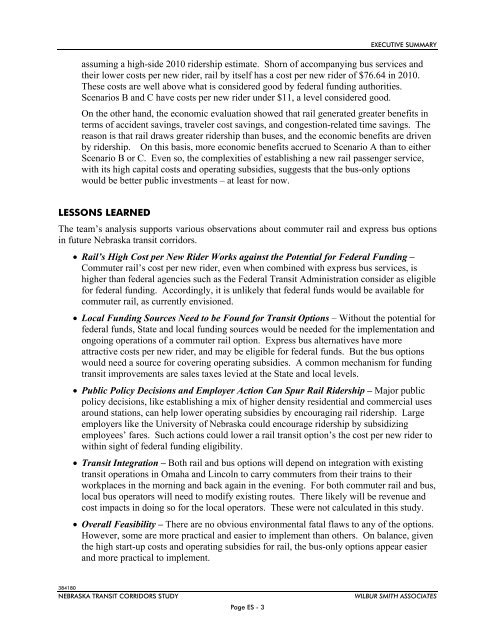NTRAC Final Study - Nebraska Department of Roads - State of ...
NTRAC Final Study - Nebraska Department of Roads - State of ...
NTRAC Final Study - Nebraska Department of Roads - State of ...
Create successful ePaper yourself
Turn your PDF publications into a flip-book with our unique Google optimized e-Paper software.
EXECUTIVE SUMMARY<br />
assuming a high-side 2010 ridership estimate. Shorn <strong>of</strong> accompanying bus services and<br />
their lower costs per new rider, rail by itself has a cost per new rider <strong>of</strong> $76.64 in 2010.<br />
These costs are well above what is considered good by federal funding authorities.<br />
Scenarios B and C have costs per new rider under $11, a level considered good.<br />
On the other hand, the economic evaluation showed that rail generated greater benefits in<br />
terms <strong>of</strong> accident savings, traveler cost savings, and congestion-related time savings. The<br />
reason is that rail draws greater ridership than buses, and the economic benefits are driven<br />
by ridership. On this basis, more economic benefits accrued to Scenario A than to either<br />
Scenario B or C. Even so, the complexities <strong>of</strong> establishing a new rail passenger service,<br />
with its high capital costs and operating subsidies, suggests that the bus-only options<br />
would be better public investments – at least for now.<br />
LESSONS LEARNED<br />
The team’s analysis supports various observations about commuter rail and express bus options<br />
in future <strong>Nebraska</strong> transit corridors.<br />
Rail’s High Cost per New Rider Works against the Potential for Federal Funding –<br />
Commuter rail’s cost per new rider, even when combined with express bus services, is<br />
higher than federal agencies such as the Federal Transit Administration consider as eligible<br />
for federal funding. Accordingly, it is unlikely that federal funds would be available for<br />
commuter rail, as currently envisioned.<br />
Local Funding Sources Need to be Found for Transit Options – Without the potential for<br />
federal funds, <strong>State</strong> and local funding sources would be needed for the implementation and<br />
ongoing operations <strong>of</strong> a commuter rail option. Express bus alternatives have more<br />
attractive costs per new rider, and may be eligible for federal funds. But the bus options<br />
would need a source for covering operating subsidies. A common mechanism for funding<br />
transit improvements are sales taxes levied at the <strong>State</strong> and local levels.<br />
Public Policy Decisions and Employer Action Can Spur Rail Ridership – Major public<br />
policy decisions, like establishing a mix <strong>of</strong> higher density residential and commercial uses<br />
around stations, can help lower operating subsidies by encouraging rail ridership. Large<br />
employers like the University <strong>of</strong> <strong>Nebraska</strong> could encourage ridership by subsidizing<br />
employees’ fares. Such actions could lower a rail transit option’s the cost per new rider to<br />
within sight <strong>of</strong> federal funding eligibility.<br />
Transit Integration – Both rail and bus options will depend on integration with existing<br />
transit operations in Omaha and Lincoln to carry commuters from their trains to their<br />
workplaces in the morning and back again in the evening. For both commuter rail and bus,<br />
local bus operators will need to modify existing routes. There likely will be revenue and<br />
cost impacts in doing so for the local operators. These were not calculated in this study.<br />
Overall Feasibility – There are no obvious environmental fatal flaws to any <strong>of</strong> the options.<br />
However, some are more practical and easier to implement than others. On balance, given<br />
the high start-up costs and operating subsidies for rail, the bus-only options appear easier<br />
and more practical to implement.<br />
384180<br />
NEBRASKA TRANSIT CORRIDORS STUDY<br />
Page ES - 3<br />
WILBUR SMITH ASSOCIATES

















